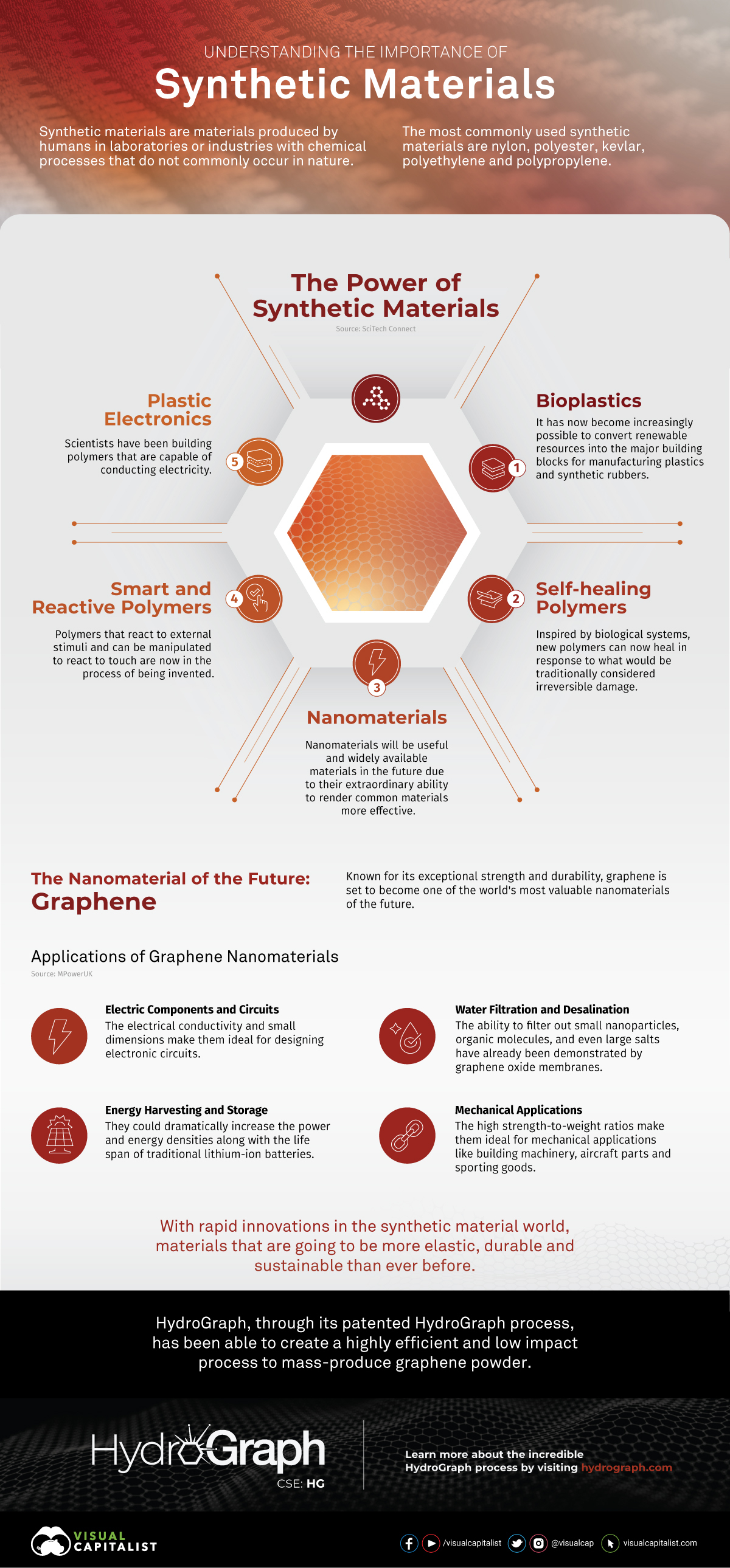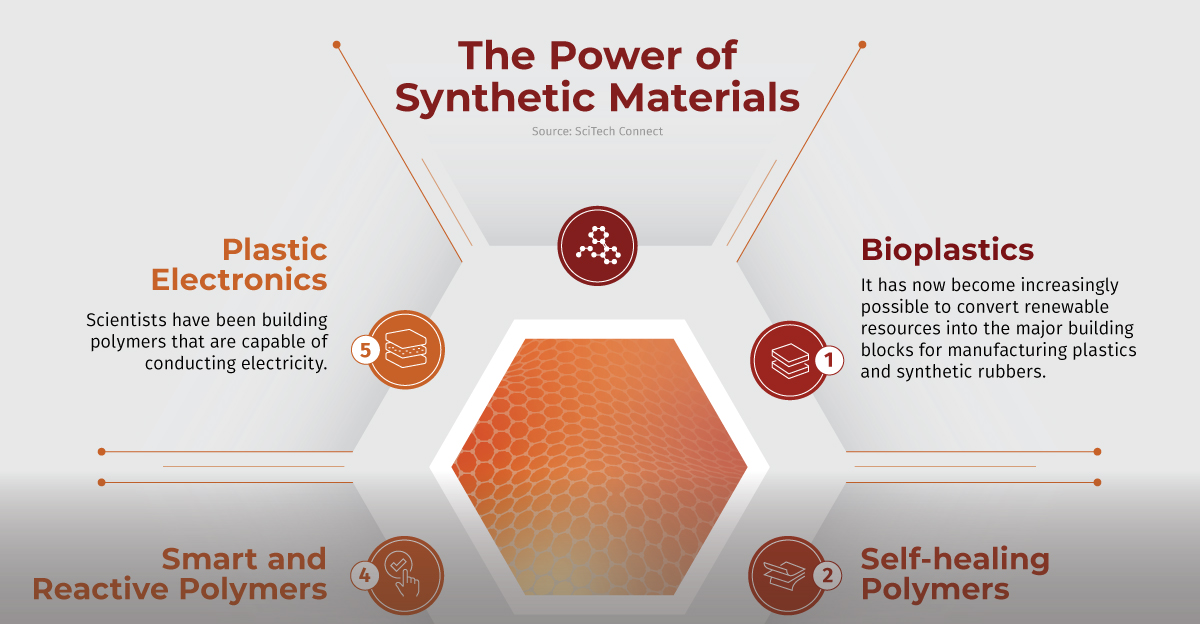Synthetic Materials That Will Shape the Future
The following content is sponsored by HydroGraph

Synthetic Materials That Will Shape the Future
Synthetic materials have been in our lives for a considerable time now. Since the introduction of nylon in the 1940s, we have used synthetic materials in almost every aspect of our lives.
We have synthetic materials everywhere—from garments and medicine to sportswear and tactical gear. So what are synthetic materials anyway?
Materials produced by humans in laboratories or industries with chemical processes that do not commonly occur in nature are known as synthetic materials.
In the above infographic from HydroGraph, we look at the synthetic materials that have the potential to change the future.
Five Synthetic Materials with the Power to Change the World
Chemists have discovered new catalysts and developed new synthetic routes to create materials with really specific applications.
Today, synthetic materials have gone beyond everyday household items to shape several major industries. Here are five types that will be instrumental in the future:
1. Bioplastics
As we are often reminded, plastics do not degrade and are visible sources of environmental pollution. To complicate things further, the building blocks of these materials, which we call monomers, are historically derived from crude oil, a non-renewable resource.
But that is now changing. Bioplastics are plastics that either: originate from a renewable resource, are biodegradable, or are both. Bioplastics represent an evolution within the plastics marketplace due to their benefits as new applications and technologies are developed.
2. Plastic Electronics
Initially discovered in the late 1970s, plastic electronics represent an expanding technology that brings us a myriad of products incorporating flexible and transparent electronic circuits.
Rather than relying on conventional, rigid, and brittle silicon chips to process information, plastic technology relies on novel organic materials on which the coding can be printed.
Current state-of-the-art microchip factories are about the size of three football fields and require purpose-built facilities. In contrast, plastic electronic circuits have the potential to be created in small laboratories.
3. Self-Healing Polymers
Self-healing is a well-known phenomenon in nature: a broken bone merges after some time, and if the skin is damaged, the wound will stop bleeding and heals again.
This concept can be mimicked to create polymeric materials with the ability to regenerate after they have suffered degradation or wear.
Inspired by biological systems, new materials can now heal in response to traditionally irreversible damage. Current research in this field shows how different self-healing mechanisms can be adapted to produce even more versatile materials.
4. Smart and Reactive Polymers
Gels and synthetic rubbers can easily adjust their shape in response to changes in their surroundings, like temperature or acidity.
This turns out to be incredibly useful in designing intelligent materials for sensors, drug delivery devices, and many other applications.
Mechanophores, for example, are molecular units that can alter the properties of a polymer when subjected to mechanical forces. These could have any number of industrial applications, especially through the incorporation of self-healing technology.
5. Nanocomposites and Nanomaterials
Nanomaterials are synthetic composites that are less than 100 nm in length. They are clustered together in multiple rows to produce an incredibly light and flexible, yet durable synthetic material.
Due to these properties, nanomaterials have several essential applications in aviation and space, chemicals, and aeronautics, as well as in products related to optics, solar hydrogen, fuel cells, batteries, sensors, and power generation.
Also, given that one of the most pressing challenges of our time is finding alternative, environmentally-friendly energy sources, nanomaterials are a crucial component in applications such as solar cells, paints, and other applications in green chemistry.
The Strength Of Graphene Nanomaterials
Graphene has emerged as one of the most promising nanomaterials because of its unique combination of exceptional properties.
This disruptive technology could open up new markets and even replace existing technologies or materials. No other material has the breadth of graphene’s superlatives, making it ideal for countless applications.
From medicine, electronics, and defense, to desalination, art restoration, and alternative fuels, the impact of graphene research is substantial.
Substantial research and production of nanomaterials like graphene are already on their way. HydroGraph, through its patented HydroGraph process, has been able to create a highly efficient and low impact process to mass-produce graphene powder.
Click here to learn more about HydroGraph and its wide array of product offerings.
-

 Sponsored3 years ago
Sponsored3 years agoMore Than Precious: Silver’s Role in the New Energy Era (Part 3 of 3)
Long known as a precious metal, silver in solar and EV technologies will redefine its role and importance to a greener economy.
-

 Sponsored7 years ago
Sponsored7 years agoThe History and Evolution of the Video Games Market
Everything from Pong to the rise of mobile gaming and AR/VR. Learn about the $100 billion video games market in this giant infographic.
-

 Sponsored8 years ago
Sponsored8 years agoThe Extraordinary Raw Materials in an iPhone 6s
Over 700 million iPhones have now been sold, but the iPhone would not exist if it were not for the raw materials that make the technology...
-

 Sponsored8 years ago
Sponsored8 years agoThe Industrial Internet, and How It’s Revolutionizing Mining
The convergence of the global industrial sector with big data and the internet of things, or the Industrial Internet, will revolutionize how mining works.


